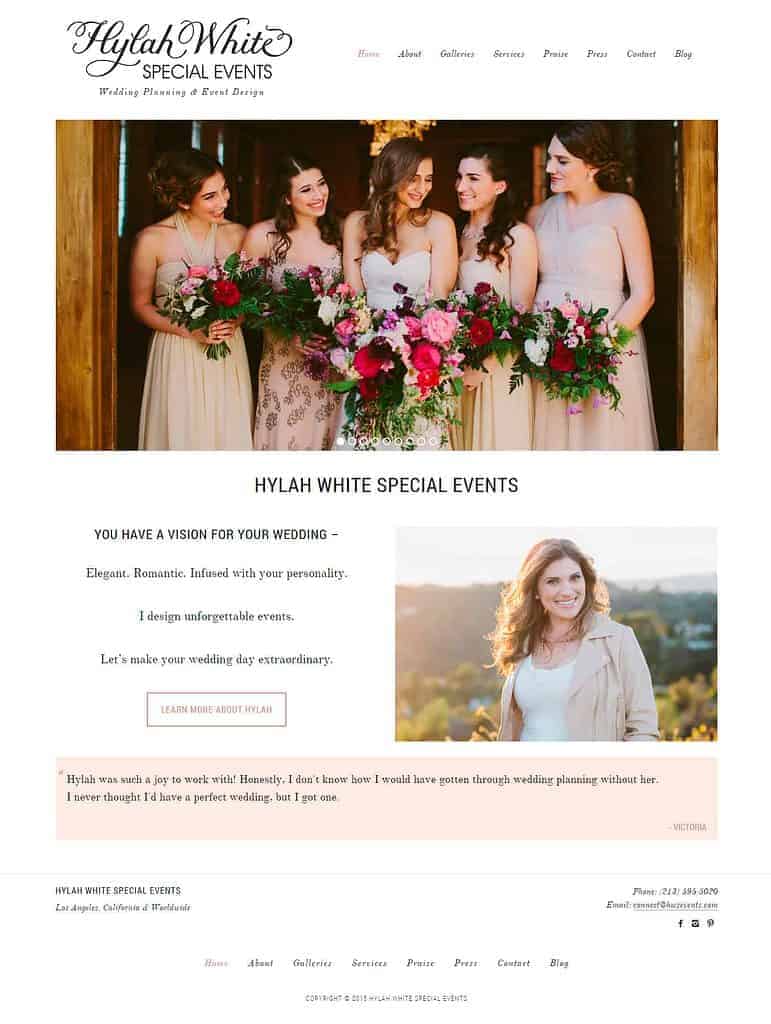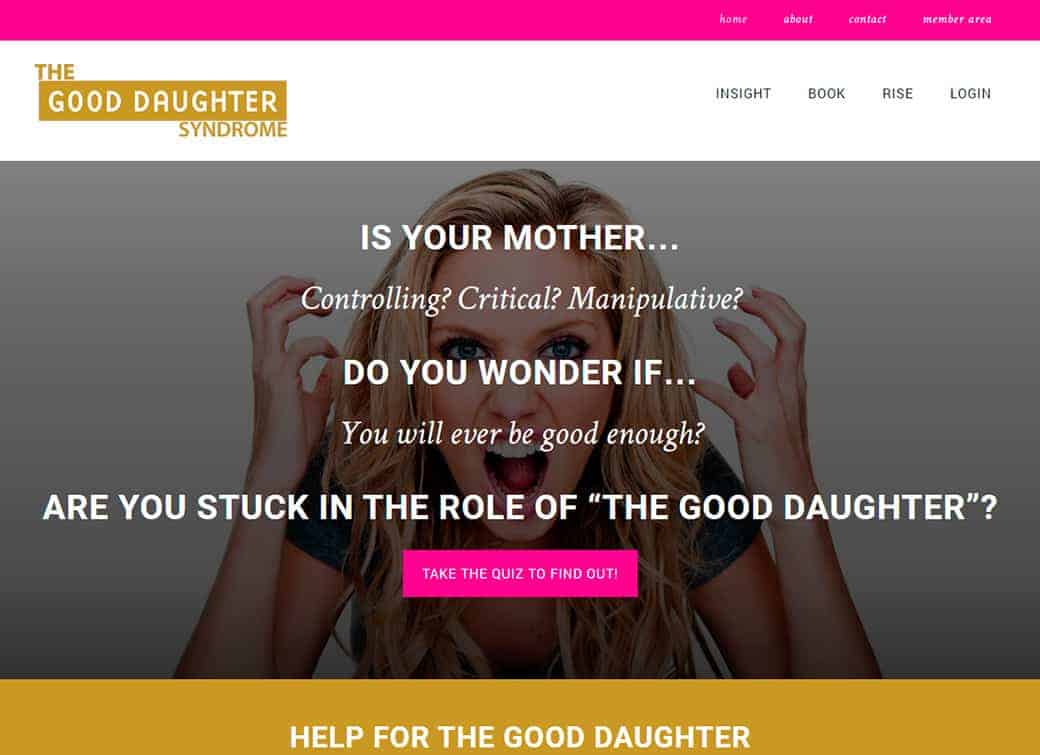This is a contribution by Erin Flynn
How I raised my rates (and how you can too!)
Back when I started my web design business, I priced my websites at around $500. I’d been making websites for years (about 12 at that point) but had only done a few random freelance jobs, and wasn’t confident in my abilities in doing design for someone other than myself.
I even dropped my price to work on projects that I thought I wouldn’t get otherwise. I think I charged $150 for my first ecommerce site (which was a BEAST).
It’s no wonder that after my first year in business I only walked away with $12,000, despite working like crazy.
I “celebrated” my first year in business by drinking cheap wine and crying.
Over the past five years, I’ve raised my prices, a LOT.
Now, the most basic website I design and develop starts at $8,500. Most websites I work on range between $10,000-$20,000. That’s a far cry from where I was just a few years ago.
Sometimes I make more in a single month than I did in my entire first year in business.
How crazy is that?!
But how did I do it? I worked on improving five major areas of my work:
- Built a solid foundation
- Stopped doing everything
- Became more selective
- Designed the customer experience
- Stopped selling websites
Let’s break these all down.
Improvement #1: How I built a solid foundation
Clients will pay more for a better website.
And to build a great website, you need to have a solid foundation in a few different skills. Why?
A great website has many components, and while you shouldn’t try to be an expert in everything (more about that later), you need to know how everything works together in order to build an effective website.
You should understand the basics
Having a good foundation in each of those areas will vastly improve your skills in whichever area you choose to specialize in.
Think of it this way: an architect designing a house needs to understand more than how the house will look, but also how people will use the house, and some physics, to ensure the house design is possible and doesn’t collapse.
Likewise, a web designer needs to understand more than just how the website will look, but how visitors will use the website, and what’s realistic for a developer to code.
You don’t need to know everything, but you do need a basic understanding.
First, I focused on improving my designs
I used to just throw things up on a page, add as many effects and “pops” as I could, and call it good. Things were busy, and unfocused. My designs looked cheap, so I got cheap clients.


I took online classes to get better. And they helped a lot! But what helped the most was practicing. Find a design you like? Try recreating it, then put your own spin on it. Design for fun. Create fake projects and design them!
Marketing + design delivers results for your clients
When you combine marketing and design, and design a website around achieving goals, it does a lot more than just look pretty. It delivers results to your clients.
I re-worked my entire process from creating a design and sticking the client’s content into it, to taking the client’s content and overall goal and designing the website around it.
By starting at the end result the client wanted to achieve and working backwards, I was able to design websites that funneled visitors into taking specific actions. This meant that my clients were making more sales and willing to pay more for my services.
Amping up the development game with custom solutions
Previously I would design what I knew how to code, and that was that. But since I was now designing with specific goals in mind, sometimes I would have to learn new coding skills in order to achieve those goals.
Sometimes a client would need a solution that didn’t already exist, and I would have to code one. It’s how I got better.
There are so many ways to learn!
Even just 5 years ago, there weren’t as many options. I remember buying that massive WordPress For Dummies book that was 4 books in one, and going through it.
Now, there are tutorials on YouTube, classes all over the internet, WordCamps and other conferences, and no excuse not to build a solid foundation.
But the best way to learn is by doing, always stretch yourself a little with projects, work on your projects to put new skills to use, and never stop learning.
Improvement #2: How I stopped doing everything
Clients will pay more for a specialist, than they will for a generalist.
If you find out you have old wiring in your house that needs replacing, who will you call? A handyman who knows a little about a lot, or an electrician, who is an expert in wiring? Probably the electrician, because you don’t want your house to burn down.
And when a potential client is searching for a new design for their recipe blog, do you think their searching for, “someone who offers all of the web services,” or, “web design for food bloggers,”?
When you’re starting out as a freelancer, you have to do everything. It’s just you, so you’ll be doing everything from answering emails, to the design, to the development. That’s really common, and totally okay.
But there will come a point where it becomes too much. You can’t be an expert in everything.
I talked about how I improved my skills in design, marketing, and development. That was necessary, but as I got better and better at each, I realized that each of those things is a full-time job. I don’t have time for three full-time jobs.
You can only get so far doing everything, before you need to specialize. It’s simply too much to do everything, and be good at everything.
Choose your specialty
After you’ve established a solid foundation, it’s time to choose your specialty. Will you become the best designer, strategist, or developer?
Or maybe something else?
I’m actually BEST at project management. I can communicate with clients, keep things organized, and bring together great designers, marketers, and developers to create an effective website. I never would have realized my strengths and weaknesses without trying everything.
And now, people hire me for the experience as much as the results–both of which I’ll talk about a little later.
The important thing is that you should choose one area to focus on, and become REALLY great at. Constantly improve your skills, and learn your specialty inside and out.
Specializing in one area means that you can charge more.

Stop doing everything
Clients will pay more for someone who is an expert in one area, instead of a generalist. Why? Because the work you do will be much higher quality. You’ll be able to go much deeper into your area of expertise, and deliver better results.
Team up with others who specialize in complementary industries. Brand designers, copywriters, SEO experts–there’s a lot that goes into making an effective website, and you can’t do it all. Find others who can help. Together you can charge more than you can individually.
Improvement #3: How I became more selective about who I work with
Clients will pay more if you don’t work with just anyone.
We talked about specializing in a skill, but it’s equally important to specialize in who you serve. This is commonly known as “niching” which basically means choosing a specific type of client to target.
When I first started I took on any and every client who came my way. Again, that’s a normal thing we do when we’re new to freelancing. But as soon as I niched, I got MORE clients (I thought I’d get fewer), and they were much more fun to work with.
A food blogger is going to want to work with a designer who knows about food blogging. A real estate agent is going to want to work with someone who understands real estate. An infopreneur is going to want to work with someone who knows about selling digital products.
Why YOU need to niche your web design business
Just like focusing on a specific skill, like design, makes you better at design, choosing a specific audience will help you serve them better–and will help attract the clients you want to work with!
You may not know this, but certain industries like real estate, have all sorts of crazy things they are legally required to include on their websites. If you leave something off, your client could get in legal trouble–and you might too!
But you would never know that if you don’t know enough about the real estate industry.
Of course, not all industries are like that. But when you understand the industry you are working with, you better understand their problems and can offer better solutions.
You can’t possibly know the ins and outs of every industry, but you can know the ins and outs of the paleo blogging industry, or the wedding photography industry, or whatever industry interests you, that you want to serve.
When you understand your niche, you’re able to speak directly to them, address their concerns, and offer solutions.
And that means potential clients will be able to find you, much more easily!
Potential clients are far more likely to hire someone who understands what they do, and the struggles they face, than someone who doesn’t. Being clear about who you work with will attract more of the right clients.
How to find your niche
The best niche is something you’re interested in and passionate about. Why? Because if you’re going to be researching, staying up-to-date with, and working with people in a specific niche, you don’t want to get bored! It will be much easier if you’re interested in your niche and enjoy being a part of it.
A simple “formula” for figuring out your niche is:
So for example,
Whatever you choose, being able to go in-depth into the industry and really understand what your clients are struggling with will help you serve them better.
Speak to your niche by using their language
Once you’ve decided on your niche, you need to speak to them. Show them that you know their industry inside and out, and address their concerns and how you can offer solutions.


Make it clear who you serve as soon as people land on your website. You can do this through branding, your tagline, the websites you showcase in your portfolio, and the content you create.
Write articles directly targeted to your audience that will help them.
Be selective with the clients you accept
Choosing to be selective with who you work with, helps establish yourself as an expert who understands their industry and can help them solve their problems
Choose your niche based on your skills and interests.
Speak to your niche to specifically address their problems and offer solutions.
Potential clients will be more likely to hire you than someone who works with everyone, because you understand their needs.
Improvement #4: How I created a great experience for my clients
“People will forget what you said, people forget what you did,
but people will never forget how you made them feel.”
Maya Angelou
Clients will pay more for a better experience.
The customer experience starts from the second a client lands on your website, sees you on social media, or meets you in person.
And it doesn’t end when the contract is signed. You can’t just give up, and say, “Well, they can’t get out of it now.”
You have to carry the experience through the entire project, and beyond.
The customer experience starts with your branding
It’s true: the customer experience does start with your branding, and how you present yourself and your business.
What does your brand say about you? Is your company friendly, down-to-earth, and welcoming? Or high-end, chic, and exclusive?
As you create your brand and put yourself out there, think about how you want customers to feel, and make sure that that feeling emanates from everything that you do.
Earlier in my business, I had tried to emulate brands I thought were doing well, but they were so NOT me, it was hard to keep up with. It was exhausting pretending to be something I wasn’t, and I found that I was attracting clients I didn’t even enjoy working with.
I re-worked my branding so that it felt true to me, and gave clients the feeling I wanted to convey. The experience felt natural, and clients felt happier.
Clients will pay more for a brand that makes them feel good and that speaks to them.
As you create or audit your brand and put yourself out there, think about how you want customers to feel, and make sure that that feeling emanates from everything that you do.
Streamlined Processes help customers stay loyal and happy
Part of creating a great customer experience is making sure everything runs smoothly.
When I was new to business, I wasn’t organized. I didn’t know how to be, because I didn’t know what my processes were or what to expect. Even just 5 years ago, there weren’t the resources there are today to help new designers figure out how to organize and streamline their businesses.
So I had to figure it out on my own.
After I had worked with a few clients I sat down and mapped out the paths the projects had gone on, looked for where things went wrong or were confusing, and made note of what had worked well.
From there, I was able to create a plan for future projects, with a clear process that I could follow and lead my clients on.
It was a lot of work, and it took a lot of refinement over 2-3 years, but eventually I figured out what worked for me and my design business.
I still recommend sitting down and mapping out your processes. But you can now get all sorts of maps and plans for you to follow so that you’re not starting from scratch, or reinventing the wheel with each client.
Clients will pay more for a smooth and enjoyable experience.
Communication
Communicating is the MOST important part of the experience for your clients.
While my design and development skills have improved, the main reason I get hired is because I talk to my clients–when other designers and developers don’t.
Look, I get it, I’m an introvert too. But when clients are paying you thousands of dollars to build something for them, you need to communicate!
When you keep clients regularly updated (even a weekly email), they are less likely to get antsy and become a nightmare client.
When you take the time to explain why you designed something the way you did, or the difference between a domain and a host, clients appreciate it.
Actually talking to and explaining things to my clients gave me the best word of mouth and referrals.
I don’t mean you need to give clients every single little detail of the project and overwhelm them with information and terms they don’t need to know. But keep them informed, and answer their questions. It goes SUCH a long way in creating a great experience for your clients. And people are willing to pay more for a great experience.
Clients will pay more if you give them more attention and communicate with them.
Create a great experience
In short, creating a great experience is a science:
- The experience starts with a client’s first interaction with you–create a strong brand
- Keep the experience positive throughout the project with a smooth process
- Communicate with your clients so they know what’s going on during the project
Improvement #5: How I stopped selling websites
“Clients don’t want a product. They want a solution.”
Unknown
Clients will pay more for a solution to their problems.
If you only get one thing out of this presentation, let it be that you have to stop selling websites. Immediately.
Like most designers, when I started out I sold websites. I don’t anymore.
Sell the solution
The truth is: clients don’t want a website. They want a solution to their problems.
Once I stopped focused on selling bundles of code and graphics and started focusing on solving my clients’ problems, I was able to raise my prices significantly.
Imagine you’re the client. You might pay $1,500 for a website. It sits there, looks pretty, and you know you need one, because the internet says so. But if all it does is sit there and not do anything, the amount you’d spend on it is probably pretty low.
But what if that website could get you new leads? Convert browsers into buyers? Reduce your workload? You’d pay a heck of a lot more for that, wouldn’t you?
Clients will pay more for a solution to their problems.
Determine your client’s’ problems
The first step in finding a solution to your client’s problems is finding out what their problems are.
If you are very niched, all of your clients may have the same or similar problems. But if you work with a variety of clients their problems may differ.
But you have to know what their problems are in order to offer a solution.
You can do a little sleuthing, follow your potential clients on social media and see what they’re struggling with, then address these issues in your website copy and marketing.
Or, you can ask them directly. Literally hop on a call with those you would like to have as clients, and ask what problems they’re facing. Make notes, and use this information to figure out how you can help.
(You can also ask in Facebook groups, at meetups, or anywhere you can interact with your target audience.)
Make sure you truly understand your clients’ problems so you can offer a clear solution.
How can you help?
Not every problem is fixable with a website, but a surprising amount are.
If your client wants to grow her audience before a product launch, you can design a website that funnels visitors to opt-in forms and gets them on her list.
If your client has to process intake or registration forms manually, you can automate that process for her, which will save her time.
If your client wants to teach classes to students all over the country, but can’t travel everywhere, you can help her teach through her website.
If your client wants to make more sales, you can design a website that generates more sales by making products easier to find and purchases easier to make.
Those are just a few examples of problems your clients may be facing, that you can solve for them with a strategic website.
How can a website help YOUR clients?
How much is that solution worth to your clients?


Stop selling websites! PLEASE.
Let’s compare a few options, that I see a lot of web designers doing.
Which would you buy?
Designer A’s Package:
– 3 Mockups
– 3 page templates
– Widgetized home page
– 2 opt-in forms
Price: $1,500
Designer B’s Package:
– 3 Mockups
– 5 page templates
– Widgetized home page
– 2 opt-in forms
Price: $1,500
The only difference is that Designer B is offering 5 pages templates, instead of 3. For the same price. You’d go with Designer B because you get more for your money.
Now which would you buy?
– Widgetized home page
– 2 opt-in formsPrice: $1,500
Designer C’s Solution:
– Increased conversions
– More clients
– Less admin work
Price: $5,000
Now it’s less of a contest. You’re not comparing apples to apples, you’re comparing a website to a solution. And clients want a solution.
By the way, I’m not saying you should bullet point your solutions like this, that’d be a little weird. But I am saying that if you focus less on the tech, and more on the benefits, clients will pay more.
Clients will pay more for something that will make them more money or save them more time. Instead of focusing on the technical aspects of what you’re doing, focus on how what you do helps your clients achieve their goals and solves their problems.
Stop selling websites
Clients will pay more for something that will make them more money or save them more time.
So: once you understand your client’s problems, offer them a solution
Don’t focus on the tech, focus on solving problems.
How To Raise Your Web Design Rates Successfully By Creating a Balanced Business
Going from just getting by to making good money rarely happens overnight. But it doesn’t have to take forever.
Work on building a solid foundation. Stretch your abilities and always keep learning.
Choose a skill to focus on and become truly amazing at.
Be selective about who you work with–this will set you apart as an expert.
Create the best customer experience that you can. A great experience is worth paying for.
Sell the benefits. Stop selling code and graphics. No one wants a website, they want to make more money. They’ll spend money to make money.
—
About Erin Flynn
Erin has been making websites since 1999, and started her own web design and development company in 2012. After a few years of creating websites for clients, Erin shifted her business. Now, her primary business is helping other designers and developers navigate the difficult waters of entrepreneurship by providing courses and guides to teach everything from how to start a web design business to how to deal with nightmare clients.
When she’s not teaching designers or working with her own design/development clients, Erin can be found exploring the mountains near her home in Aspen, Colorado.
Don’t run your web design business alone–join the Unstoppable Basecamp and get the support you need!







